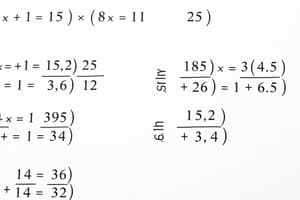Podcast
Questions and Answers
What is Method 1 for factoring polynomials?
What is Method 1 for factoring polynomials?
- Trinomial
- Greatest Common Factor (correct)
- Sum of Squares
- Difference of Cubes
What is the first step in Method 2: Grouping?
What is the first step in Method 2: Grouping?
Group the terms in pairs.
What is the factorization of a squared difference according to Method 4?
What is the factorization of a squared difference according to Method 4?
- a^2 + b^2 = (a + b)(a - b)
- a + b = (a - b)^2
- a^2 - b^2 = (a + b)(a - b) (correct)
- a^3 - b^3 = (a - b)(a^2 + ab + b^2)
Method 5 states that a^2 + b^2 can be factored.
Method 5 states that a^2 + b^2 can be factored.
What does Method 6: Difference of Cubes factor to?
What does Method 6: Difference of Cubes factor to?
What does Method 7: Sum of Cubes factor to?
What does Method 7: Sum of Cubes factor to?
The ______ property allows you to add or multiply numbers regardless of how they are grouped.
The ______ property allows you to add or multiply numbers regardless of how they are grouped.
The ______ property states that the order of addition or multiplication does not affect the result.
The ______ property states that the order of addition or multiplication does not affect the result.
A prime expression is an expression with primes.
A prime expression is an expression with primes.
How is a polynomial expressed in factors according to the 'Factor Completely' method?
How is a polynomial expressed in factors according to the 'Factor Completely' method?
Define a conjugate.
Define a conjugate.
What happens to the middle term when applying the Tips for Difference of Squares?
What happens to the middle term when applying the Tips for Difference of Squares?
Flashcards are hidden until you start studying
Study Notes
Factoring Methods for Polynomials
-
Greatest Common Factor (GCF): Identify and factor out the highest common multiple of all polynomial terms. Always apply this method first.
-
Grouping: Utilized for polynomials with four terms, involving two steps:
- Step 1: Group terms to form two pairs. For example, (3xy + 3y + 2ax + 2a) becomes ((3xy + 3y) + (2ax + 2a)).
- Step 2: Factor out common elements from each group, forming binomials: ((x+1)(3y+2a)). Verify results using the FOIL method, paying attention to signs.
-
Trinomial Factoring: Reverses the FOIL method to find two binomials. Required that the middle term equals the sum of the outer and inner products: (a^2 - b + 1) factors to ((a+b)(a+b)).
-
Difference of Squares: Applies when given two terms in the form (a^2 - b^2), factoring to ((a+b)(a-b)). Ensure it involves two terms being subtracted.
-
Sum of Squares: Cannot be factored further as (a^2 + b^2) is prime. Identifies polynomials represented by two added terms.
-
Difference of Cubes: Utilizes the formula (a^3 - b^3 = (a-b)(a^2 + ab + b^2)). Requires both terms in the polynomial to be cubes and be in a binomial format.
-
Sum of Cubes: Factors as (a^3 + b^3 = (a+b)(a^2 - ab + b^2)). Recognizes that both terms are cubes and emphasizes the need for sign changes in the middle term.
Fundamental Properties
-
Associative Property: States that the grouping of numbers does not affect the result in addition or multiplication; the placement of parentheses is inconsequential.
-
Commutative Property: Order of numbers in addition or multiplication does not change the product; the sequence of terms can be rearranged freely.
-
Distributive Property: Explains multiplication of a sum by distributing over each term separately and then combining the products; frequently used in FOIL expansions.
Mathematical Definitions
-
Prime Expression: An expression that cannot be factored into simpler expressions; has no prime factors.
-
Factor Completely: The process of writing an expression as a product of prime factors only.
Common Cubes and Squares
-
Common Cubes (n³):
- Values include 1, 8, 27, 64, 125, 216, 343, 512, 729, and 1000 for integers 1 through 10.
-
Common Squares (n²):
- Values include 1, 4, 9, 16, 25, 36, 49, 64, 81, and 100 for integers 1 through 10.
Additional Concepts
-
Conjugate: Two similar expressions or quantities that differ only by the sign in the middle, significant in simplification processes.
-
Tips for Difference of Squares:
- Having a positive and negative term leads to cancellation of the middle term.
- If both terms are even, 2 is a common factor, aiding in simplification.
Studying That Suits You
Use AI to generate personalized quizzes and flashcards to suit your learning preferences.




